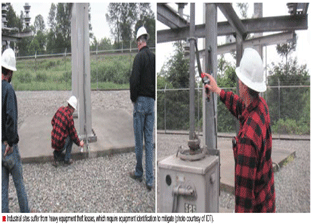Assembly plants and construction sites pose a number of significant security challenges, as they are often located in areas that are surrounded by farmland and open fields. In addition, thieves can easily scale landscape walls and commercial wrought-iron fences that protect such sites with access roads and rail lines providing thieves with not only easy access, but also means of a quick getaway. Given the value of the tools and equipment, higher levels of loss prevention measures are desperately needed.
Assembly plants and construction sites pose a number of significant security challenges, as they are often located in areas that are surrounded by farmland and open fields. In addition, thieves can easily scale landscape walls and commercial wrought-iron fences that protect such sites with access roads and rail lines providing thieves with not only easy access, but also means of a quick getaway. Given the value of the tools and equipment, higher levels of loss prevention measures are desperately needed.
.gif)
"In the past few years, we have seen tremendous growth in use of video security, specifically CCTV cameras and recorders, in industrial environments," said Dvir Doron, Vice President of Marketing for ioimage. "In turn, this has created the baseline for introducing intelligent video as a means to transform reactive monitoring into proactive security, relying on automated detection and tracking of intruders, vehicles and other threats. Beyond theft of metal, vandalism and inventory shrinkage, some industries tied to military and government organizations face increased threats from terrorism."

Major companies involved in securing industrial sites, said one industry source, include Bosch, Pelco, LG, Axis Communications, NVT, IFS, GE, Sony, Samsung, Capture, Infinova, Verint, Neurodynamics, Genex, IntilliVid, Aralia, Nice, Agent Vi, Vistascape, ioimage, Vidient, 3VRSecurity, Javelin, Tyco, Tamron, and AD Sensormatic. As for access control used in such projects, Fargo, Indala, HID Global, Kaba, Honeywell Security, Mitsubishi Electric, Abymatic, Napco, Optex, Senstar- Stellar, IESA, and C&K lead. For alarms, Abymatic, Tyco, DSC, CIAS Elettronica, Rokonet, DSC, Honeywell Security, Paradox and Bosch are the main players.
The U.S. Federal Bureau of Investigation has stated that the highest-profit, lowest-risk business venture in the U.S. is stealing from construction sites. According to the U.S. Association of General Contractors, estimated losses to the construction industry in 2005 were US$1.2 billionequivalent to stealing $5 from every citizen in the U.S.

"While not an exact figure, it is safe to say theft on construction sites results in at least $1 billion in losses each year in the U.S.," stressed Frank Rosenthal, Director, Advanced Sourcing at the Dewalt Jobsite Security Group of Black & Decker. "The use of security solutions requires a new way of thinking. In many respects, people have resolved themselves to some level of theft, which they, in turn, build into project costs. Developing the market requires that we educate users regarding more proactive ways of addressing the problem."
Lack of employment prospects means that people are stealing scrap and telephone cables. Security systems at assembly plants are essentially the same, said Celso Calazans, owner of Brazil's Emforvigil S.A. Cultural differences, however, can be important factors. "All companies have loss prevention policies. Some metals, however, have a higher aggregate value in a given country. That means that, in certain cases, statistical factors that detail theft of metal and related materials and any financial losses dictate use of electronic security. How much a company channels employees, equipment and money to this end depends on the value of products to be protected; the more that is invested in assets, the better the protection."

Simply adding cameras, however, is not enough. Guards cannot continuously watch monitors; the likelihood, therefore, that they can spot intruders on displays featuring an expanded array of cameras is not good. Fence detectors and ground sensors are often too rudimentary because they cannot differentiate legitimate activities, such as ground tremors caused by passing vehicles and trains, wildlife and weather, and genuine alarm-worthy events. Any alarm from a system that does not provide visual confirmation would likely require a response that would consume valuable security staff resources (false alarms).
Effective Solutions for Equipment Theft
Black & Decker has two products for the metal and equipment theft vertical. The first consists of a base unit with a vibration and infrared motion sensor. It also has a keypad, LCD display, siren, strobe light, battery backup and, most important, a cell phone and landline phone for sending out information on alarm status. Other sensors can be installed within 2,000 feet of the base unit; these communicate wirelessly when they sense an alarm condition. These wireless sensors include a typical door or window contact sensor, passive infrared (PIR) motion sensor and two specialized sensors developed especially for use in securing construction sites.
One of the two latter sensors is mounted onto a large tool box and/or material storage container. The other consists of an industrial cable loop that, when broken or tampered with, sends alarm messages to the base unit. This can be used to secure ladders, motorized equipment and gates. The cable is wrapped around and through the device for better protection. In many ways, the product is very similar to typical home security systems; the main distinctions are that it is completely wireless and completely portable.
Another Black & Decker product is its all-in-one portable alarm unit with tracking; this measures three inches by five inches with no display, buttons or user interface. Within the device are vibration, temperature, magnetic contact (door/window applications) and tamper sensors that track the device when it is moved. The device is mounted (magnetically or via fasteners) to asset that users wish to protect and program onboard sensors and arm or disarm the unit via either the Web site or interactive voice response (IVR) telephone menu system. When the unit senses an alarm, it calls the user and/or sends out an email/text message. The user can then respond as desired, say going to the Web site to locate the unit via onboard assisted GPS (AGPS).
Intelligent Systems
Intelligent systems can reduce spending, said Calazans, but mindsets must change. Major components include alarms, CCTV systems and access controlall are directly related to efficiency and investment value. The more restricted the area of the industrial site, the lower the operational, administrative and financial costs. Most systems incorporate active tools such as sirens, lights and shocks to surprise intruders. Additional measures include smoke bombs to disorient intruders.
"Open areas, however," Calazans cautioned, "require different measures. This is where intelligence comes into play." These are used in conjunction with physical barriers (perimeters), microwave sensors, microphone cables, infrared sensors and buried cables.
Intelligent, dome and fixed cameras, IP and algorithm-based video analytics are all used in both internal and external areas, said Calazans. Monitored alarms also play a heavy role in combating theft. "In outdoor environments, the big news is buried cables, microwave sensors, microphone cable and optical fiber. Intelligent cameras use artificial intelligence to detect intruder direction and movement. They sound alarms only when people are detected, thus avoiding false alarms."
Biometrics, he noted, is an efficient tool internally, but is less cost-effective for outdoor areas. Cost of implementing voice, iris, facial, hand geometry and number plate readers can be very high. He recommended that users look to Crime Prevention through Environmental Design (CPTED) concepts; these are architectural designs that combine equipment, intelligence and strategies.
Passive control systemstagsare being used to prevent theft (both internal and external). The most attractive targets are precious metals, electronic equipment (portable computers, PDAs and cellular phones, hospi tal and measuring equipment; employee theft usually involves tobacco, tires, medicine and clothing.
In mos t other cases , Calazans recommend 24-hour surveillance, effective security personnel rounds, internal and external monitoring, access control systems, metal detectors, armed guards during transportation of metals and other assets, product scanning, containers, and, finally, monitored intrusion alarms. These are among the technologies, he said, that have been best-received.